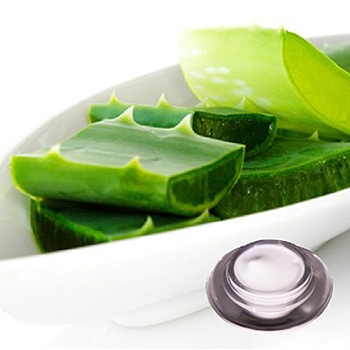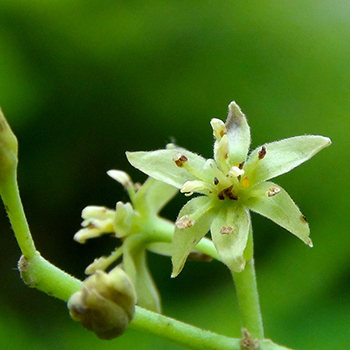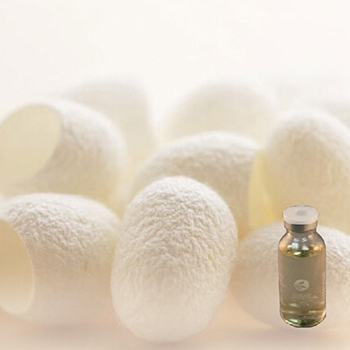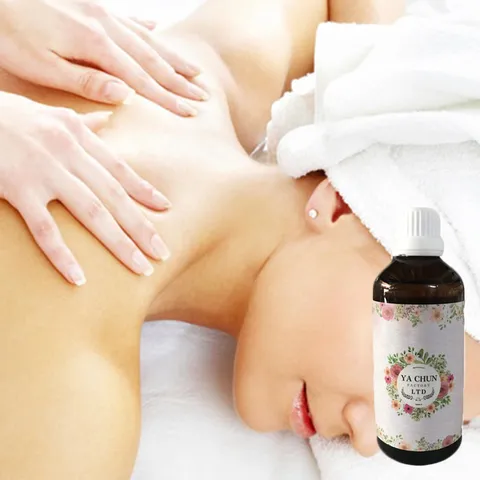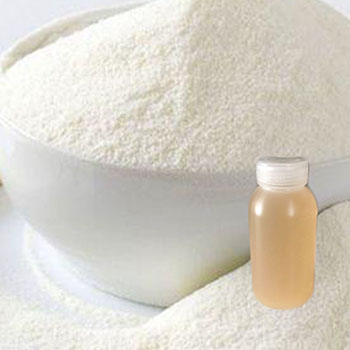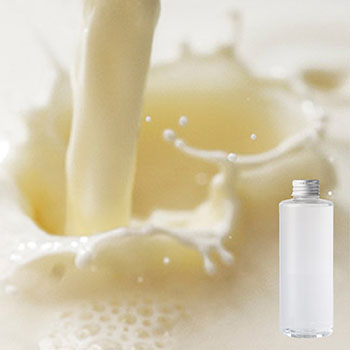目前購物車內沒有商品

Hawthorn fruits contain complex of biological active substances: flavonols, tannic substances, sterols, vitamin C, carotenoids, leucoanthocyanidins, anthocyans, triterpen saponins, sugar, organic acids, pectins, fatty oil. The flowers contain flavonol, essential oils, carotenoids, caffeic, oleanolic and ursolic acids, acetylcholine, choline and trimethylamin, the leaves - quercetin, tannin, vitamin C, carotene, triterpenoid saponin.
Chemical definition: Mixture of flavonoid glycosides, saponins, procyanidins, trimethylamine, tannins.
Assay: Not less than 1.8% vitexin (Liquid chromatography)
Product Applications: : Hawthorn (Crataegus oxyacantha) has been used for years, primarily in Europe, for its reported ability to nutritionally support proper cardiovascular function-including heart strength and normal blood pressure. It is believed to acts to preserve and protect the heart tissue, increase the strength of myocardial (heart muscle) contractions and improve coronary blood flow. Hawthorn is also a rich source of procyanidins that have reported sedative and antispasmodic effects. Hawthorn is also a known cardio-tonic that is believed to help restore normal blood pressure (both high and low). Hawthorn is also cited in the management of irregular heartbeats, spasms of the arteries, and certain nervous disorders, such as insomnia. European clinical studies have documented Hawthorn's effectiveness.
Therapeutical Categories: Cardio-tonic, hypertension, blood pressure
Hawthorn's flowers, leaves and berries are all used in herbal supplements. Each is high in flavonoid content, which gives the plant powerful antioxidant properties. By inhibiting free radical formation, hawthorn's antioxidant activity can be beneficial in maintaining healthy heart vessels and promoting overall heart health.
Research Indicates
» Helps balance blood pressure
» Used by practitioners for help in preventing angina attacks
» Research indicates hawthorn may help preserve collagen
» May be useful for promoting restful sleep
» Believed to support heart and circulatory system health including heartbeat, blood flow, control of artherosclerotic plaque
» May be useful in treatment of Raynaud’s disease and varicose veins
Function:
contain powerful antioxidants and natural bioflavonoids that support the health of the entire cardiovascular system. This herb can actually help regulate both high and low blood pressure, in addition to slowly breaking down cholesterol and fat deposits in the body. Restrain the conglomeration of blood platelet, expanding coronary artery to improve the blood supply of cardiac muscle, reducing the oxygen consumption of cardiac muscle; good effect to the bloodless heart disease. reduce blood fat and pressure. Suitable for coronary heart disease, insufficiency coronary artery blood supply, angian and heart vein disease.
Effectively part of with structure
Leucoanthocyanidins

Spend a green vegetable at first(Procyanidins, call PC.The other has ever used of the English has proanthocyanidins, leucoanthocyanidins, pycnogenol)is extensively existent in the plant Kingdom of one generic name of the big polyphenol compound.The inception Tong returns to match the Rou quality or yellow alkane Chun in the Suo.Along with separate Jian settle the exaltation of[with] technique and to this kind of thorough research of material and the deep understanding, Be already come creating new style now of one big material and call it as an original flower to teach a vegetable.
In 1961, the German Karl(2) waited for the ethanol of the fresh fruit to withdraw to separate 2 kinds of polyphenol compounds for the very first time in the thing from the British hawthorn Crataegus oxyacantha;In 1967, the American Joslyn waited for"again separated 4 kinds of polyphenol compounds from the grape skin and the seed withdrew a thing, they got of the polyphenol compound heated and all can produce to spend in the acidity lie the quality green vegetable(cyanidins), past named after this polyphenol compound at first to spend a green vegetable.
The original flower teaches a vegetable is combined by the son tea vegetable or the form son tea vegetable of different quantity and become.Most simply original spend a green vegetable is the son tea vegetable or the form son tea vegetable or the son tea vegetable and the form son tea vegetable formation of two gather a body, still have in addition three gather a body, four gather a body etc. keep to ten to gather a body.
Press size of coming together the degree, usually will two?Four gather a body to be called low gather a body(the procyanidolic oligomers, the brief name OPC), will five gather a body to be called above high gather a body.(the procyanidolic polymers, the brief name PPC)Two gather a body in, match the dissimilarity of the position because of two Gou elephants of single bodies or the Jian, can have various different constructions, have already separated 8 kinds of structure forms that the Jian settles to named after B1 respectively?B8, among them, B1 B4 by C 4 → C8 keyses match, B5?B8 by C 4 → C6 keyses match.
In every variety at first the flower the green vegetable, two gather a body to distribute most widely, research most, is the most important a type of original flower to teach a vegetable.Three gather a body in, also because single body constituted and it connects with each other the carbon atom position of different become the structure of various each kind and named after C1, the C is 2 ……etc..Among them, the C1 distributes in the nature the most abundant.
It is a powerful anti- oxygen.The business extracts a thing is generally changed into an OPC content by standard.The anti- oxidizes a plain growth of nourishment of is more than 60 different health condition risks into the floodgate possibility constringency, include the aging process, cancer and arteriosclerosis.
The anti- oxygen can't get away from the heavy metals and melting agent, but they reduce to injure them to cause when they is there.When the toxin stroll passes your body, they cause the unsteady numerator that the reaction of the metabolism causes a free radicals(damage health organization).The anti- oxygen cleans them.Oxidize nourishment with the increment anti- vegetable your into floodgate together, you should try you the best reduce to the revelation of the free radicals is from the industry, sun, X-shoot the line, automatic tail spirit, the mercury, Ge, lead, the cigarette smoke and other chemistry ware and compound from the food, water and the air.
Active Component and Structure
Flavonoid
1. -hyperoside
2. -vitexin
3. -vitexin rhamnoside
4. -quercetin
5. -kaempferol

Tannin
C76H52O46
Any of a group of astringent substances found in the seeds, skins, and stems of grapes, as well as in oak barrels, particularly new ones. Tannins are part of a grouping technically called phenolic compounds. They are important in the production of good red wines because they provide flavor, structure and texture and, because their antioxidant traits contribute to long and graceful aging. Tannins often give young wines a noticeable astringency, a quality that diminishes as the wine ages, mellows, and develops character. Wines with excessive tannins are referred to as tannic. See Glossary of Wine Tasting Terms
Whichever seed in grape in the material of a group of astringencies, find in the skin and caulis, together with in the oak the wooden bucket, in particular and lately some. The list is rather sour is the mixture that goes together with the parts of technique of the row to be called Fen up. They provide taste, the structure and quality, so they are very important in the production of the good red wine with, because their antioxidant special features contributes to a desire and daintiness of aging. The list is often rather sour to give the young wine an eye-catcher astringency, reducing as a quality of the wine age, mature of.
INTRODUCTION
Extracts of several Chinese medicinal herbs have been shown to have anti-HIV-1 activity, which is correlated with the concentrations of polyphenolic compounds in the extracts. Our previous study has demonstrated that the polyphenolic compounds isolated from two antiviral herbs interact with the peptides derived from the HIV-1 gp41, suggesting that the active components in these herbs may inhibit HIV-1 entry by targeting gp41. Tannin (also named tannic acid) is a polyphenolic compound with a potent anti-HIV-1 activity. It has been proposed that tannin inhibited HIV-1 replication by targeting the HIV-1 reverse transcriptase, protease, and intergrase. It is interesting to know whether tannin also inhibits HIV-1 entry into target cells and what is the mechanism of action.
HIV-1 gp41, a transmemberane subunit of the envelope glycoprotein, plays an important role in the early steps of virus entry into target cells. After HIV-1 binding to CD4 and a coreceptor (CXCR4 or CCR5) on the target cell, gp41 changes conformation from a native state to an intermediate state, then to a post-fusion state, in which the N- and C-terminal heptad repeat regions (NHR and CHR, respectively) interact with each other to form a six-helix bundle, which brings both the viral and target cell membranes into proximity for fusion. Peptides derived from the NHR and CHR regions, designated N- and C-peptides, respectively, such as N36 and C34, can mimic the NHR and CHR regions to form the six-helix bundle. C-peptides can also interact with the gp41 NHR region to interfere with the interaction between NHR and CHR regions, thus blocking HIV-1 fusion. Similar, any compound that interacts with the gp41 NHR region may also block the six-helix bundle formation and inhibit HIV-1 entry into target cells. Using a monoclonal antibody (NC-1) specific for the gp41 six-helix bundle[12], we previously developed a sandwich enzyme-linked immunosorbent assay (ELISA) to screen for HIV-1 entry inhibitors targeting gp41[13] and identified the first non-peptidic HIV-1 fusion inhibitor (ADS-J1)[14]. The present study was simed to investigate whether tannin inhibited HIV-1 entry into target cells by interfering with the gp41 six-helix bundle formation.
MATERIALS AND METHODS
Reagents MT-2 cells, HIV-1IIIB chronically-infected H9 (H9/HIV-1IIIB) cells, and HIV-1IIIB were obtained from the AIDS Research and Reference Reagent Program, NIH, USA. The rabbit polyclonal antibody (PAb) and mouse monoclonal antibody (MAb) specific for the gp41 six-helix bundle were prepared and characterized as previously described[12,13]. Rabbit and mouse IgG were purified using protein-A kits (Pierce, Rockford, IL). Peptides N36 and C34 were synthesized by a standard solid-phase FMOC method in the MicroChemistry Laboratory of the New York Blood Center. The peptides were purified to homogeneity by high-performance liquid chromatography (HPLC). The identity of the purified peptides was confirmed by laser desorption mass spectrometry (PerSeptive Biosystems). Tannins were purchased from different sources: Tannin 1 (Sigma, T-8406, product of Japan); Tannin 2 (Sigma, T-0125, product of China); Tannin 3 (Fluka, 48812, product of Switzerland); Tannin 4 (Fluka, 48811, product of the USA); Tannin 5 (Riedelde Haen, 16201, product of German). The purity of tannin 1 to 5 is 96 %, 80 %, 92 %, 92 %, and 87 %, respectively. They have a similar structure, as shown in Fig 1.

Fig 1. The chemical structure of tannin.
HIV replication The inhibitory activity of tannin on HIV-1IIIB replication was determined as previously described Briefly, 1´104 MT-2 cells were infected with HIV-1IIIB (100 TCID50) in 200 µL RPMI-1640 medium containing 10 % FBS in the absence or presence of compounds at graded concentrations at 37 ºC for overnight. Then the culture supernatants were removed and fresh media were added. On the fourth day post-infection, 100 µL of culture supernatants were collected from each well, mixed with equal volumes of 5 % Triton X-100 and assayed for p24 antigen. The percentage of inhibition of p24 production and the IC50 values were calculated as described previously.
HIV-1 mediated cell fusion A dye transfer assay was used for detection of HIV-1 mediated cell fusion as previously described. H9/HIV-1IIIB cells were labeled with a fluorescent reagent, Calcein-AM (Molecular Probes, Inc, Eugene, OR) and then incubated with MT-2 cells (ratio=1:5) in 96-well plates at 37 ºC for 2 h in the absence or presence of tannin at graded concentrations. The fused and unfused Cacein-labeled HIV-1-infected cells were counted under an inverted fluorescence microscope (Zeiss, Germany) with an eyepiece micrometer disc. The percentage of inhibition of cell fusion and the IC50 values were calculated as previously described.
Sandwich ELISA A sandwich ELISA was modified as described previously and used for determining the inhibitory activity of tannin on the gp41 six-helix bundle formation. Briefly, peptide N36 (2 µmol/L) was preincubated with compounds at graded concentrations at 37 ºC for 30 min, followed by addition of C34 (2 µmol/L). For testing the effect of tannin on the pre-formed six-helix bundle formation, peptide N36 was preincubated with C34 at 37 ºC for 30 min before addition of tannin. After incubation at 37 ºC for 30 min, the mixture was added to wells of 96-well polystyrene plates which were precoated with NC-1 IgG (2 mg/L). Then, polyclonal antibody (IgG 5 mg/L) purified from rabbit antisera directed against the gp41 six-helix bundle[13], horseradish peroxidase-conjugated goat-anti-rabbit IgG (Boster Biotechnology Inc, Wuhan, China), and the substrate, 3,3',5,5'-tetramethylbenzidine (TMB) (Sigma) were added sequentially. Absorbance at 450 nm (A450) was determined spectrophotometrically by an ELISA reader. The percentage of inhibition of the six-helix bundle formation and IC50 values were calculated as previously described[13].
All the experiments were repeated at least twice. Similar results were obtained. One set of the representative data was shown here.
RESULTS
Tannin inhibited HIV-1 replication Since tannin is a non-uniform polyphenolic compound, we collected tannins from different sources and compared their in vitro cytotoxicity and inhibitory activity on HIV-1 gag protein p24 production. As determined by the trypan blue exclusion assay, none of these tannins had detectable cytotoxicity at the final concentration of 2.5 g/L. All these tannins significantly inhibited p24 production (Tab 1, Fig 2), confirming that tannin indeed inhibits HIV-1 replication, as indicated by reduction of p24 antigen production. Their IC50 values, ranging from 5.76 to 20.65 mg/L, are unrelated to their purity and structure. The discrepancy will be further investigated.
Tab 1. Inhibitory activity of tannins from different sources on HIV-1 infection and the gp41 six-helix bundle formation.

1) IC50 and IC90: mg/L for 50 % and 90 % inhibition, respectively.

Fig 2. Tannins from different sources inhibited HIV-1 replication.
Tannin inhibited HIV-1-mediated cell-fusion Fusion of HIV-1-infected cells or HIV-1 virions with target cells is the crucial step of HIV-1 entry into target cells. Therefore, HIV-1-mediated cell fusion assays have been used for identification of HIV-1 entry inhibitors. In the present study, tannins were tested for their inhibitory activity on HIV-1-mediated cell fusion. The results showed that all tannins from different sources inhibited fusion of HIV-1IIIB-infected H9 cells with uninfected MT-2 cells (Fig 3) with IC50 values varying from 5.41 to 10.24 mg/L (Tab 1), indicating that tannin is a potent HIV-1 entry inhibitor.

Fig 3. Tannins blocked HIV-1 mediated cell fusion.
Tannin interfered with the gp41 six-helix bundle formation We previously developed a sandwich ELISA for identification of HIV-1 entry inhibitors targeting gp41 using synthetic peptides N36 and C34 that mimic the gp41 NHR and CHR regions and a conformation-specific MAb NC-1 which recognize the gp41 six-helix bundle. Later, we modified this method in order to enhance its sensitivity. As shown in Fig 4, MAb NC-1 did not recognize individual peptides N36 and C34, but significantly bound to the complex formed by mixing N36 and C34 at equimolar concentra-tion.
The complex formation was blocked by a small molecular HIV-1 fusion inhibitor, ADS-J1. This result confirms the modified sandwich ELISA is sensitive and specific for detection of the inhibitory activity of anti-HIV-1 agents that block the gp41 six-helix bundle formation.

Fig 4. Determination f the gp41 six-helix bundle formation by a modified sandwich ELISA.
The inhibitory activity of tannins on the six-bundle formation was determined using the modified sandwich ELISA. As shown in Fig 5, all the tannins from different sources effectively inhibited the six-helix formation between the peptides N36 and C34 with IC50 values about or less 1 mg/L (Tab 1), suggesting that tannins block the interaction between the gp41 NHR and CHR regions to form the fusion-active six-helix bundle, thus inhibiting HIV-1 fusion and entry.

Fig 5. Tannins inhibited the HIV-1 gp41 six-helix bundle formation in a dose-dependent manner.
Since the six-helix bundle formation was quantitated based on the amount of the MAb NC-1 bound to the complex captured on the plate, one may argue that the reduction of absorbance at 450 nm may not be due to the inhibition of six-helix bundle formation, but rather the blockage of NC-1 binding to the six-helix bundle by tannin. To exclude this possibility, tannins were added to the pre-formed six-helix bundle before addition of the MAb NC-1. As shown in Fig 6, tannins did not interfere with NC-1 binding to the pre-formed six-helix bundle, confirming that tannin specifically interacts with a component of gp41 for inhibiting the six-helix bundle formation. Furthermore, this result also suggests that tannin cannot disrupt the pre-formed six-helix bundle, which is an extremely stable post-fusion gp41 core structur.

Fig 6. Effect of tannin on the gp41 six-helix bundle formation before and after N- and C-peptide interaction.
DISCUSSION
It has been reported that tannin is a potent inhibitor of HIV-1 replication by targeting the viral proteins that mediate the late steps of HIV replication, eg, HIV-1 reverse transcriptase, protease, and intergrase. The present study has demonstrated that tannin inhibits not only HIV-1 replication, but also HIV-1 entry into target cells as indicated by blocking HIV-1-mediated cell fusion.
To study the mechanism of action, we have investigated whether tannin interferes with the formation of the gp41 six-helix bundle modeled by the N- and C-peptides derived from the NHR and CHR regions since the association of NHR and CHR to form gp41 core structure is the critical step of HIV-1 fusion.
Here we showed at the first time that tannins from different sources indeed effectively inhibited the gp41 six-helix bundle formation at the concentration less than 1 mg/L. These results suggest that tannin has multiple mechanisms of action against HIV-1, ie, blocking HIV-1 entry by interfering with the fusion-active gp41 core formation and inhibiting HIV-1 replication by targeting reverse transcriptase, protease and intergrase. At high concentrations, tannin is able to precipitate proteins or peptides.
However, we have not noticed any precipitation of the N- and C-peptides when the final concentration of tannin in the mixture reaches to 1 g/L, about 1000-folds higher than its IC50 for inhibiting the gp41 six-helix bundle formation, indicating that the activity of tannin in this assay is not due to its non-specific interaction with peptides.
Tannin is a complex and non-uniform compound with a molecule weight more than 1700 daltons. Thus, it is unlikely to be developed as an orally applicable therapeutic for treatment of HIV-1 infection. However, it can be developed as a microbicide for topical application to prevent sexual transmission of HIV-1 because tannin is a potent anti-HIV-1 agent with multiple mechanisms of action, thus having less chance to induce drug-resistant HIV-1 mutants.
Tannin is present in a variety of foods and drinks, it should have no toxic effect on human. The results obtained from the in vitro assay confirm that tannin has low cytotoxicity. Furthermore, tannin is abundant in herbs, vegetables, fruits, and bark of plants (especially the bark of the oak species). It is expected to be inexpensive for production. All in all, tannin has great potential to be developed as topically applicable microbicides for protecting high-risk populations from HIV-1 infection through sexual transmis-sion.
Active Ingredients
Hawthorn flowers, leaves and berries contain from 1 to 3 percent of compounds called oligomeric procyanidins, also called pycnogenols or leucoanthocyanidins.
There are also flavonoids making up about 1 or 2 percent of the herb. The flowers and fruits are richest in total flavonoids and also contain the most hyperoside.
Leaves of C. monogyna also contain measurable amounts of vitexin-rhamnoside. Rutin, other flavonoids, and glycosylflavones are found in much smaller quantities.
Other components include purines, sterols, and amines, some of which may stimulate the heart. In addition, there are orientin glycosides, cyanogenetic glycosides, and saponins.
Oligomericproanthocyanidin
-leucoanthocyanidins
are powerful antioxidants. Commercial extracts are generally standardized for OPC content. Increasing intake of antioxidant nutrients can shrink the risk of more than 60 different health conditions, including the aging process, cancer and arteriosclerosis. Antioxidants can't get rid of heavy metals and solvents, but they do cut down on the damage they do while they're there. As toxins wander through your body, they generate metabolic reactions resulting in free radicals (unstable molecules that damage healthy tissue). Antioxidants clean them up. Along with increasing your intake of antioxidant nutrients, you should try your best to reduce exposure to free radicals from industry, the sun, x-rays, auto exhaust, mercury, cadmium, lead, cigarette smoke and other chemicals and compounds from food, water and air.
OXYACANTHIN
37H40N2O6 An alkaloid obtained from the root of Berberis vulgaris; a white, crystalline powder with a melting point of 202-214°C; soluble in water, chloroform, benzene, alcohol, and ether; used in medicine. Also known as vinetine.

Hawthorn is considered the top plant-derived medicine used for the treatment of cardiovascular diseases in Europe. It has a mild and long sustaining action, which keeps a facilitating effect on the coronary blood flow without decrease.
Many religion-related legends about this plant have been handed down. The most famous legend is when Christ was crucified and was pricked by the thorns of a crown made of Hawthorn, his blood purified the plant. Because of this, it was used as a talisman in the ancient days.
Hawthorn has been used for the treatment of cardiac diseases from the Middle Age.
It is known that it has generally been used as an infusion and a tincture.
Today, as the research on the herb has progressed, it has turned out that the leaves, blossoms and fruit of the plant are effective in treating cardiovascular disorders.
In 1984, Commission E proved the effectiveness of Hawthorn on specific cardiac diseases. Its applied fields are clearly designated as follows:
What is the most important information I should know about OxyContin?
Do not crush, chew, or break controlled-release forms of oxycodone such as Oxycontin. Swallow them whole. They are specially formulated to release oxycodone slowly into your system. Breaking them would cause too much drug to be released into the blood at one time leading to a potentially fatal dose of oxycodone.
Use caution when driving, operating machinery, or performing other hazardous activities. OxyContin will cause drowsiness or dizziness. If you experience drowsiness or dizziness, avoid these activities.
Avoid alcohol while taking OxyContin. Alcohol will greatly increase the drowsiness and dizziness caused by OxyContin and could be dangerous.
OxyContin may increase the effects of other drugs that cause drowsiness, including antidepressants, other antihistamines, other pain relievers, anxiety medicines, seizure medicines, and muscle relaxants. Dangerous sedation, dizziness, or drowsiness may occur if OxyContin is taken with any of these medications.
Never take more OxyContin than is prescribed for you. Taking too much OxyContin could result in serious side effects, even death. If your pain is not being adequately treated, talk to your doctor.
Do not share this medication with anyone else.
What is OxyContin?
OxyContin is in a class of drugs called narcotic analgesics. It is a pain reliever
OxyContin is used to treat moderate-to-severe pain.
OxyContin may also be used for purposes other than those listed in this medication guide.
How should I take OxyContin?
Take OxyContin exactly as directed by your doctor. If you do not understand these directions, ask your pharmacist, nurse, or doctor to explain them to you.
Take each dose with a full glass of water.
OxyContin can be taken with food or milk if stomach upset occurs.
Never take more OxyContin than is prescribed for you. Taking too much OxyContin could result in serious side effects, even death. If your pain is not being adequately treated, talk to your doctor.
Do not crush, chew, or break controlled-release forms of oxycodone such as Oxycontin. Swallow them whole. They are specially formulated to release oxycodone slowly into your system. Breaking them would cause too much drug to be released into the blood at one time leading to a potentially fatal dose of oxycodone.
Occasionally, empty Oxycontin tablets may be passed out in the stool. This is not a problem. The active medication has been absorbed in the body and the empty tablet shell may appear in the stool.
To ensure that you get a correct dose, measure the liquid form of oxycodone with a special dose-measuring spoon or cup, not with a regular table spoon. If you do not have a dose-measuring device, ask your pharmacist where you can get one.
Do not stop taking OxyContin suddenly if you have been taking it continuously for more than 5 to 7 days. Stopping suddenly could cause withdrawal symptoms and make you uncomfortable. Your doctor may want to gradually reduce the dose.
Increasing the amount of fiber and water (six to eight full glasses) in your diet may alleviate constipation.
Do not share this medication with anyone else.
Store OxyContin at room temperature away from moisture and heat and out of the reach of children. When treatment with OxyContin is no longer needed, any remaining medication should be destroyed by flushing down the toilet.
What happens if I miss a dose?
Take the missed dose as soon as you remember. Do not take a double dose of this medication. Wait the prescribed amount of time before taking the next dose.
What happens if I overdose?
Seek emergency medical attention.
Symptoms of an OxyContin overdose include slow breathing, seizures, dizziness, weakness, loss of consciousness, coma, confusion, tiredness, cold and clammy skin, and small pupils.
What should I avoid while taking OxyContin?
Avoid alcohol while taking OxyContin. Alcohol will greatly increase the drowsiness and dizziness caused by OxyContin and could be dangerous.
OxyContin may increase the effects of other drugs that cause drowsiness, including antidepressants, other antihistamines, other pain relievers, anxiety medicines, seizure medicines, and muscle relaxants. Dangerous sedation, dizziness, or drowsiness may occur if OxyContin is taken with any of these medications.
Use caution when driving, operating machinery, or performing other hazardous activities. OxyContin will cause drowsiness or dizziness. If you experience drowsiness or dizziness, avoid these activities.
What are the possible side effects of OxyContin?
If you experience any of the following serious side effects, stop taking OxyContin and seek emergency medical attention or contact your doctor immediately:
an allergic reaction (difficulty breathing; closing of your throat; swelling of your lips, tongue, or face; or hives); low, weak breathing seizures cold, clammy skin; severe weakness or dizziness; or
unconsciousness Other, less serious side effects may be more likely to occur. Continue to take OxyContin and talk to your doctor if you experience
constipation dry mouth, nausea, vomiting, or decreased appetite dizziness, tiredness, or lightheadedness
muscle twitches sweating; tching; decreased urination; or decreased sex drive
Do not stop taking OxyContin suddenly if you have been taking it continuously for more than 5 to 7 days. Stopping suddenly could cause withdrawal symptoms and make you uncomfortable. Your doctor may want to gradually reduce the dose.
Side effects other than those listed here may also occur. Talk to your doctor about any side effect that seems unusual or that is especially bothersome.
What other drugs will affect OxyContin?
OxyContin may increase the effects of other drugs that cause drowsiness, including antidepressants, other antihistamines, pain relievers, anxiety medicines, seizure medicines, and muscle relaxants. Dangerous sedation, dizziness, or drowsiness may occur if OxyContin is taken with any of these medications. Drugs other than those listed here may also interact with OxyContin. Talk to your doctor and pharmacist before taking any prescription or over-the-counter medicines.
1. 1st and 2nd degree cardiac hypofunction proposed by NYHA (New York Heart Association).
2. A feeling of pressure and constriction on the site of the heart.
3. Relief of the cardiac rhythm disorder, bradycardia, in senile patients without the use of digitalis.
Physiological Functions
The application of the hairdressing
Have to refrain from rash action, the town calms down to wait for effect.
Have to disinfect disinfection, nourish, refrain from rash action, sweep, eliminate inflammation, the vitamin P function cell, afferent constringency etc. effect.
Have flavonoid derivatives FLAVONOID and spend a green vegetable, list rather, the soap corn is sweet, the list waits for a hairdressing ingredient rather.
Natural of antioxidant quality( Anti-oxidants), can resist the free radicals in the body, so had aging function of anti-.Have another a great deal of alkali vegetable with yellow type, type the yellow alkali vegetable can resist oxygenation, removing a free radicals to increase phenomenon gradually.So have already become Japan to keep and improve looks most popularly in recent years.
Have natural vitamin C, the skin of smooth your whole body.
The acceleration burns a fat to defend a fat, the hairdressing goes to a spot.
Can help your skin to regulate a grease.Its pearl light feeling, if use to be hiding the Xia product to suit to hide black rim of eye of Xia particularly, help an anti- to oxidize the help circulation, promote the skin cell to contain amount of oxygen.
Have a type of material with plain flavonoid among them, can function in the nourishment function of the vein organization, reduce blood vessel wall of wear deeply power, enhance the capillaries wall, help the blood fluxion, keep blood vessel from extending, and can prevent and from remove anasarca phenomenon.
Anti- inflammation, can strengthen the skin immunity function, have repair and maintenance skin effect
Use at the pimple skin, have to refrain from rash action, the cancellation pimple inflammation Chong blood, town quiet etc. effect.
The benefit urines a function, besides which, can also help exclusion body inside surplus of the salt and the humidity.Enhance the skin cleanness and the skin hydration and flexibility
Apply the skin quality very much:oil.General.Pimple
